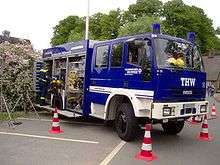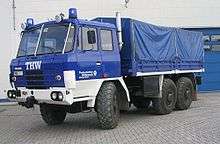Technisches Hilfswerk
| Federal Agency for Technical Relief 'Bundesanstalt Technisches Hilfswerk' | |
|---|---|
| Common name | Technisches Hilfswerk |
| Abbreviation | THW |
|
Main logo of the THW | |
| Agency overview | |
| Formed | 22 August 1950 |
| Preceding agency | Technische Nothilfe (Technical Emergency Relief) |
| Employees | 860 |
| Volunteers | 83,807 |
| Annual budget | EUR 185.879.000 (2015) |
| Legal personality | Governmental: Government agency |
| Jurisdictional structure | |
| Federal agency | Germany |
| Constituting instrument | Law on German Federal Agency for Technical Relief (THW Law) |
| General nature | |
| Operational structure | |
| Headquarters | Bonn-Lengsdorf |
| Agency executive | Albrecht Broemme, President |
| Operational units |
17
|
| Facilities | |
| Local sections | 668 |
| Website | |
| www.thw.de | |
The Bundesanstalt Technisches Hilfswerk (THW, Federal Agency for Technical Relief) is a civil protection organisation controlled by the German federal government. 99% of its 83,625 members (2014) are volunteers.
Tasks


The tasks of the THW are described in a law called THW-Gesetz.[1] These tasks are:
- technical and logistical support for other (German) GOs, NGOs or other authorities like fire brigades, police or the custom authorities
- technical or humanitarian relief in foreign countries, as assigned by the government
- technical relief in Germany as part of national civil protection measures.
History
After World War II the Technisches Hilfswerk was founded in 1950, by order of the minister of the interior. The first president of the THW was Otto Lummitzsch, who had founded the THW's predecessor, the Technische Nothilfe, in 1919. The main purpose of the THW was civil defense in the event of war. This has changed during the decades; today the THW is a helper in a wide spectrum of disasters, such as traffic accidents, industrial disasters, or earthquakes.
The largest disaster control action took place in August 2002 after the flooding of the Elbe river in eastern Germany. About 24,000 THW members participated in the operation, with up to 10,000 people helping simultaneously along the Elbe and its tributaries.
The largest engagement outside Germany was in France in 2000, after storms Lothar and Martin had destroyed much of the overhead electrical overland wires and overturned trees blocked many streets from December 26 to 28, 1999. The main contribution was supplying temporary electrical power for hospitals and other important institutions and rebuilding parts of the electrical system.
The organisation has also been active in many disaster relief operations abroad, for example after the 2004 Indian Ocean earthquake (for both relief operations and medium-term rebuilding), Hurricane Katrina in 2005, the 2005 Kashmir earthquake,[2] in 2010 during the flooding in Poland, and the 2011 Tōhoku earthquake and tsunami.[3]
Organization
As a federal authority which is part of the Federal Ministry of the Interior, the THW is headed by the president of the THW administration together with its board. The current president, from 16 May 2006, is engineer Albrecht Broemme. He previously served as the Fire Chief of Berlin. The headquarters of the THW administration and management (THW-Leitung) are in Bonn-Lengsdorf, together with the Bundesamt für Bevölkerungsschutz und Katastrophenhilfe (BBK) (Federal Office for Civil Protection and Disaster Assistance).
The THW comprises 668 THW local chapters, 66 offices, 8 regional associations, and the THW administration in Bonn, which is subject to the THW President and assists him in his daily official business. It consists of the management staff, the representative for the volunteers, and the Deployment Section with the units E1 mission, E2 foreign, E3 training, E4 logistics, and E5 technology, and the Central Services Section with the units Z1 helpers and staff, Z2 organization, Z3 finance, Z4 security and health protection, and Z5 information and communication.
The THW logistics center has its office in Heiligenhaus, and is via its attachment to the Logistics Unit E4 part of the THW administration.
Field organization
The THW is stationed all over Germany in 668 local chapters, called Ortsverbände (OV). Some 80,000 people are active in this organisation including about 15,000 young volunteers (members of the THW Youth). The majority of those are volunteers, while about 800 work full-time in its administration. Each local chapter (Ortsverband) maintains one or more Technische Züge (technical platoons), each consisting of one Zugtrupp (command squad), comprising four volunteers, two Bergungsgruppen (rescue units) comprising nine (first unit) to twelve (second unit) volunteers, and one to three Fachgruppen (Technical Units), comprising four to eighteen volunteers.

The main type of THW unit (about two out of three) is one of two Bergungsgruppen (1st and 2nd Rescue Groups), equipped with heavy tools like hydraulic cutting devices, chain saws, and pneumatic hammers. Their vehicles are the Gerätekraftwagen 1 (GKW 1) (Equipment Truck 1) for the 1st Rescue Group and the Mehrzweckkraftwagen (MzKW) (Multi-Purpose Truck) or the older Gerätekraftwagen 2 (GKW 2) — which is scheduled to be phased out — for the 2nd Rescue Group.
The Fachgruppen (Technical Units) include:
- Bridge Building, (Brückenbau)
- Command, Control and Communication, (Führung und Kommunikation)
- Debris Clearance, (Räumen)
- Demolition/Blasting, (Sprengen)
- Electricity Supply, (Elektroversorgung)
- Illumination, (Beleuchtung)
- Infrastructure, (Infrastruktur)
- Logistics, (Logistik)
- Oil Pollution, (Ölschaden)
- Search and Rescue, (Ortung)
- Water Damage / Pumps, (Wasserschaden / Pumpen)
- Water Hazards, (Wassergefahren) and
- Water Supply and Treatment, (Trinkwasserversorgung).

For relief in foreign countries, there are four Schnelleinsatzeinheiten Bergung Ausland or SEEBA (Rapid Deployment Unit Search and Rescue Abroad) units, able to go airborne within six hours,[4] and five Schnelleinsatzeinheiten Wasserversorgung Ausland or SEEWA (Rapid Deployment Unit Water Supply and Treatment Abroad) units.
Services provided
Technical threat prevention
- Area lighting
- Clearing and blasting
- Combating flooding and inundation
- Search and rescue, and salvage
- Water rescue
Infrastructure technical support
- Electricity supply
- Emergency bridge work
- Drinking water supply
- Waste water disposal
Command and communication, logistics
- Catering and care of operational staff
- Command center establishment and operation
- Command support
- Creation of temporary telecommunication systems
- Establishment and operation of logistical bases
- Maintenance of material, repair and maintenance work for mission equipment
- Transportation of consumer goods for mission demands
Technical support in the protection of the environment
- Fighting against oil damage
- Water analysis
Provision of the population
- Electricity and drinking water provision
- Establishment and equipment of emergency accommodation and collecting points with matching infrastructure
- Waste water disposal
Technical support
- Diving
- Makeshift road works
- Maintenance of civil protection facilities such as emergency wells and shelters
- Rescue from heights
- Technical help on traffic routes
Heads of THW
- 1952–1955: Otto Lummitzsch
- 1955–1958: Alexander Löfken
- 1958–1962: Rudolf Schmidt
- 1962–1977: Hans Zielinski
- 1977–1985: Hermann Ahrens
- 1985/1986: Helmut Meier
- 1986–2002: Gerd Jürgen Henkel
- 2002–2006: Georg Thiel
- since 2006: Albrecht Broemme
Personnel
See also Conscription in Germany
In Germany, military service was mandatory for adult males until 2011. Instead of joining the military for six months full-time, one of the alternatives was to join a non-combatant volunteer organisation within the German Katastrophenschutz (disaster relief) or Zivilschutz (civil defense) for a minimum of four years (this is calculated so that although serving far less time every week, in the end the number of served hours was about the same). The THW was one of those organisations, as were volunteer fire brigades and various organisations engaged in emergency medical service.
While the number of 17-year-olds moving from youth to active service was lower in 2012 (913 new members) than in 2010 (1056 new members),[5] the theory of a decisive influence by conscription on THW volunteer recruiting is not supported by empirical data.
THW-Jugend
The THW-Jugend (THW Youth) is the youth organization of the THW. It has set itself the target to introduce boys and girls from the age of ten in a playful way to the work of the THWs. The THW-Jugend is not part of the Federal Agency for Technical Relief, but is an independently registered charity. This arrangement was made in order to avoid maintaining a state youth organization.
See also
- Civil defense or Civil defense by country
- State Emergency Service — a similar organization in Australia
References
- ↑ "THW-Gesetz - Gesetz ueber das Technische Hilfswerk". Retrieved 2010-10-17.
- ↑ "Technical and Humanitarian Assistance Worldwide". Retrieved 2008-04-29.
- ↑ "Erdbeben in Japan: THW setzt Hilfe fort". Retrieved 2011-03-14.
- ↑ "The SEEBA Special Unit – the Government's Tool to Help Rescue and Salvage Operations Domestically and Abroad". Retrieved 2008-02-17.
- ↑ Bundesanstalt Technisches Hilfswerk: Jahresbericht 2012 , page 28.
External links
| Wikimedia Commons has media related to Technisches Hilfswerk. |
- Official THW-homepage in German
- Official THW-homepage in English
- An Overview of the Federal Agency for Technical Relief (THW) (PDF file)
